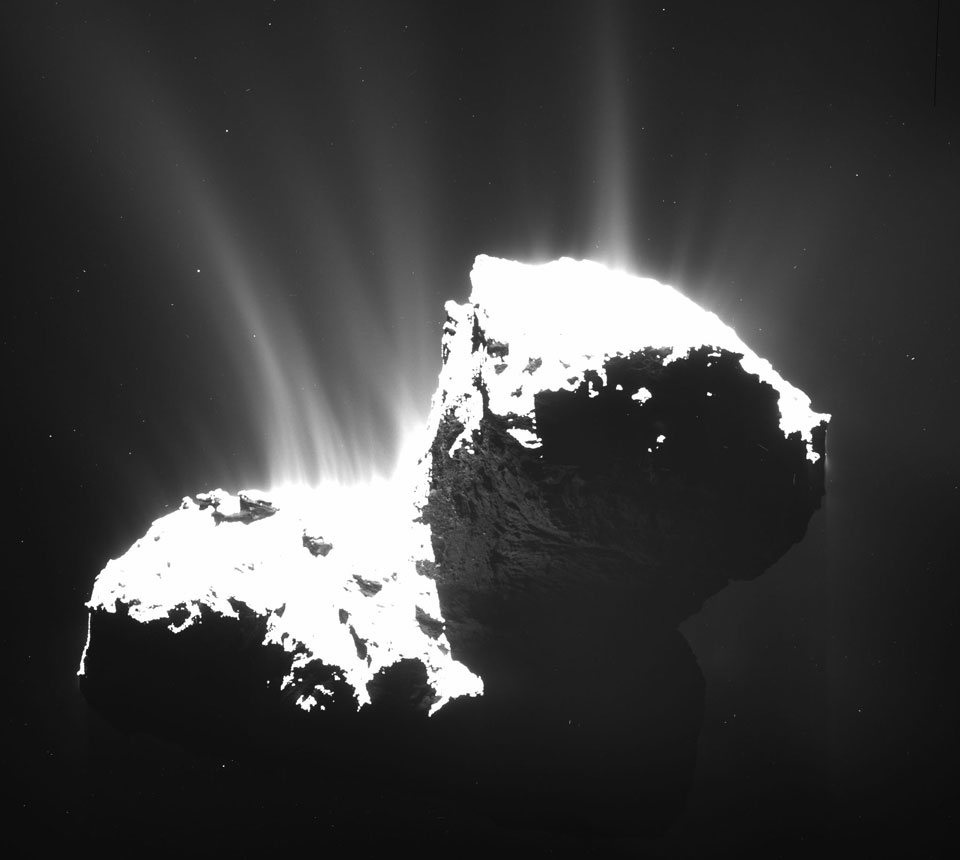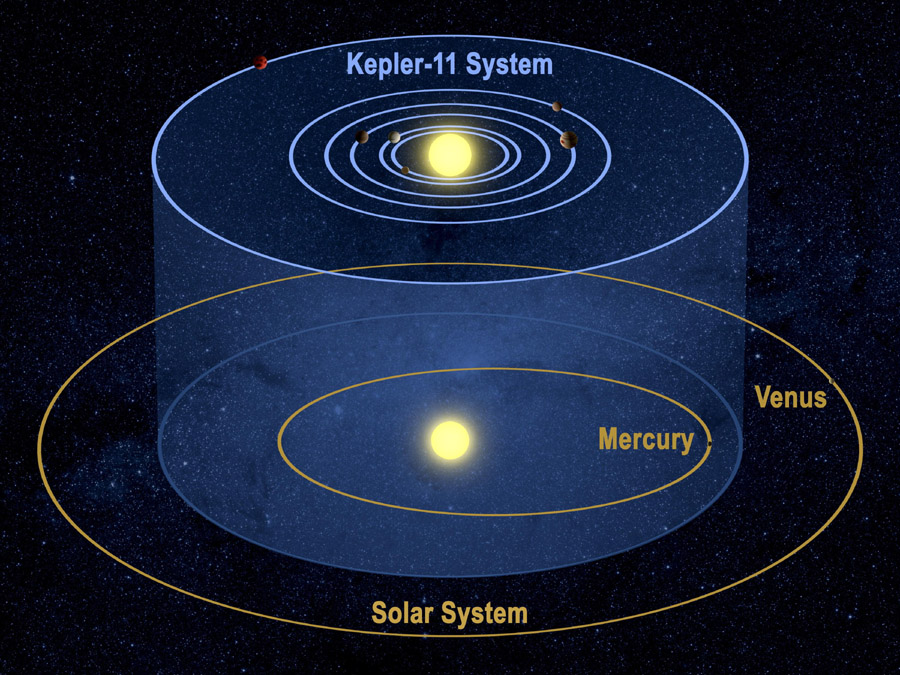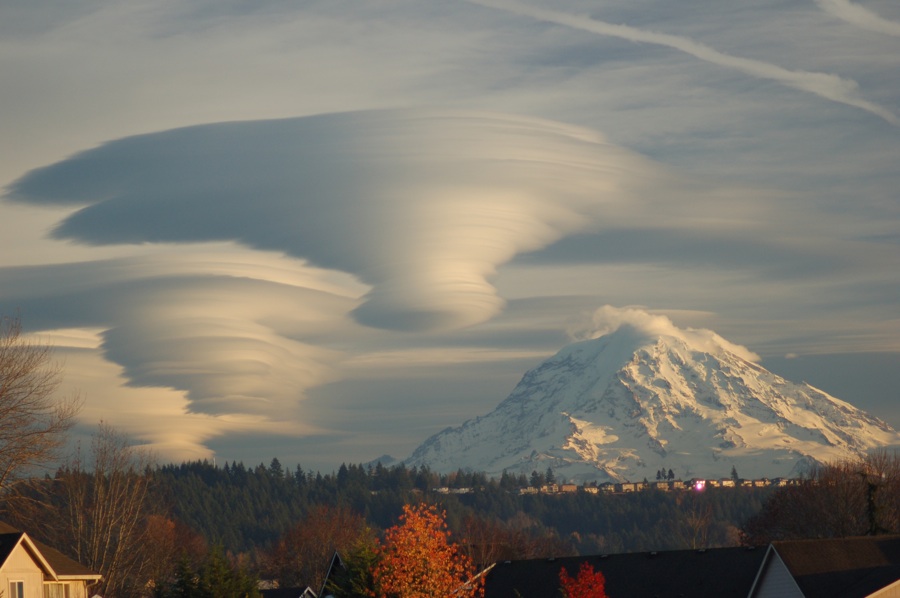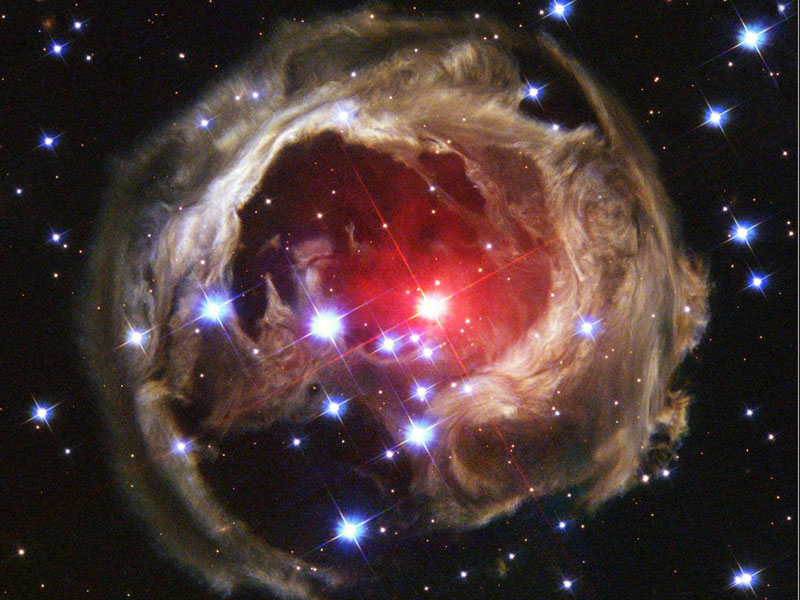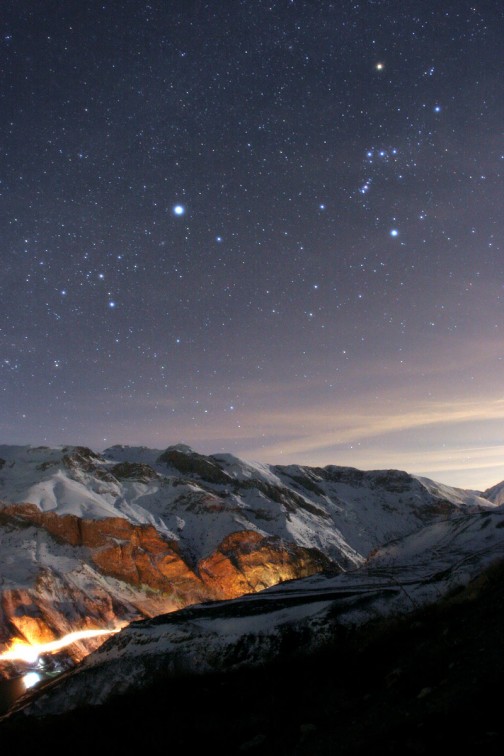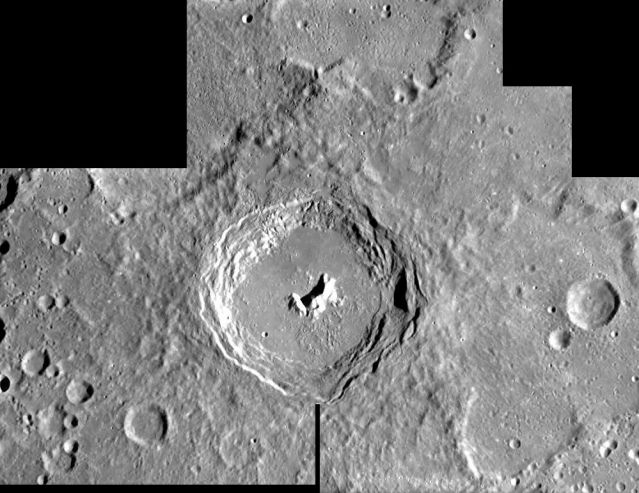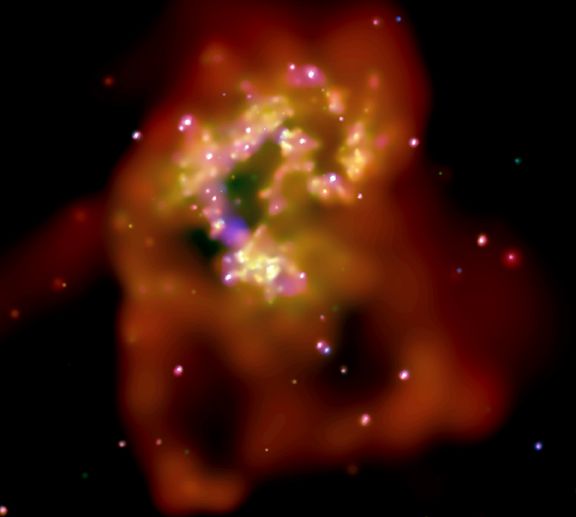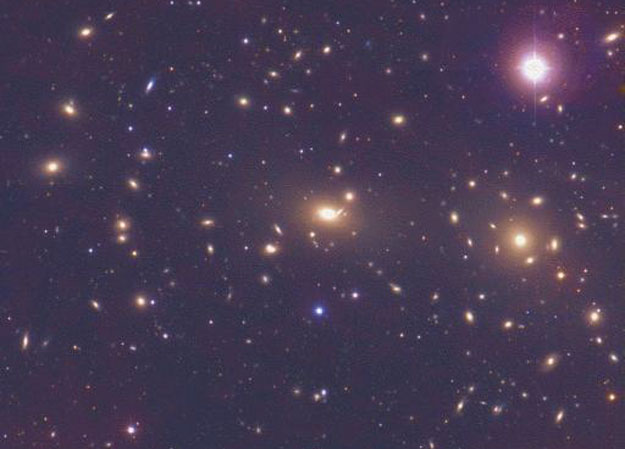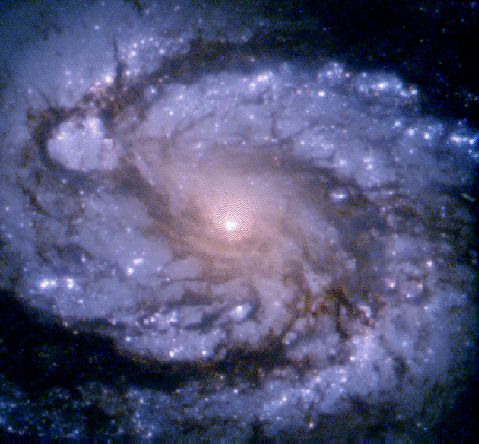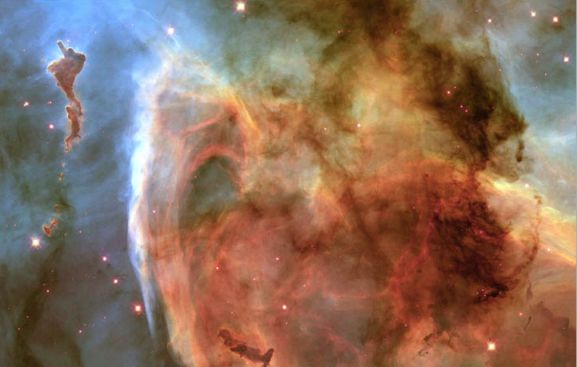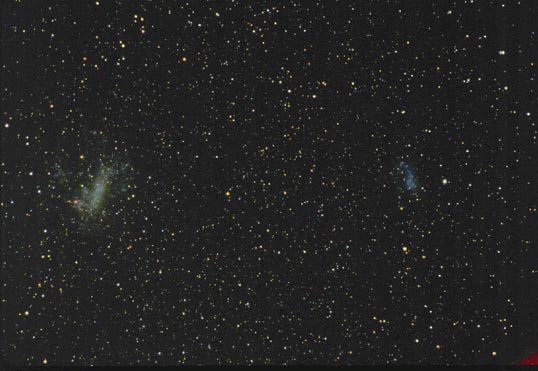| << Previous | Index | Next >> |
2015 Where do comet tails come from? Although it is common knowledge that comet tails and comas originate from comet nuclei, exactly how that happens is an active topic of research. One of the best images yet of emerging jets is shown in the featured image, taken last November by the robotic Rosetta spacecraft in orbit around the Comet 67P/Churyumov-Gerasimenko (Comet CG), and released last month. The overexposed picture shows plumes of gas and dust escaping numerous places from the Comet CG's nucleus as it nears the Sun and heats up. Although Comet CG is currently further out from the Sun than Mars, its orbit will take it almost as close as the Earth this coming August, at which time its jet activity is expected to increase by a factor of about 100. You've likely seen some debris from comet nuclei before but in another form -- when sand-sized bits end their journey through the Solar System by impacting the atmosphere of Earth as meteors.
2014 Where has the Yutu rover been on the Moon? Arriving in 2013 mid-December, the Chinese Yutu robotic rover has spent some of the past month and a half exploring Mare Imbrium on Earth's Moon. Because it uses solar power, the mechanical Jade Rabbit goes into sleep mode to endure the two-week long lunar night. Pictured above is a digitally created time-lapse composite panorama showing the region surrounding the Chang'e 3 lander, capturing the desk-sized rover in three positions. On the far right, Yutu is seen heading south to investigate greener pastures, likely never to return to its lander again.
2013 This esthetic close-up of cosmic clouds and stellar winds features LL Orionis, interacting with the Orion Nebula flow. Adrift in Orion's stellar nursery and still in its formative years, variable star LL Orionis produces a wind more energetic than the wind from our own middle-aged Sun. As the fast stellar wind runs into slow moving gas a shock front is formed, analogous to the bow wave of a boat moving through water or a plane traveling at supersonic speed. The small, arcing, graceful structure just above and left of center is LL Ori's cosmic bow shock, measuring about half a light-year across. The slower gas is flowing away from the Orion Nebula's hot central star cluster, the Trapezium, located off the upper left corner of the picture. In three dimensions, LL Ori's wrap-around shock front is shaped like a bowl that appears brightest when viewed along the "bottom" edge. The beautiful picture is part of a large mosaic view of the complex stellar nursery in Orion, filled with a myriad of fluid shapes associated with star formation.
2012
2011 Six worlds orbit Kepler-11, a sunlike star 2,000 light-years distant in the constellation Cygnus. The new discovery is based on data from NASA's planet hunting Kepler spacecraft. Compared to our Solar System in this illustration, five of Kepler-11's planets orbit closer to their parent star than the Mercury-Sun distance, with orbital periods ranging from 10 to 47 days. All six are larger than Earth and are likely composed of mixtures of rocky material and gas. Their presence, sizes, and masses have been determined by carefully watching the planets dim the light of Kepler-11 while transiting or crossing in front of the star itself. In fact, in August 2010, Kepler's telescope and camera recorded a simultaneous transit of three of the planets in the system. As announced yesterday, using the transit technique the Kepler mission has now identified over 1200 exoplanet candidates in a field of view that covers only about 1/400th of the sky. The tantalizing result suggests there are many undiscovered planets orbiting the stars in our galaxy.
2010 What is this strange object? First discovered on ground based LINEAR images on January 6, the object appeared unusual enough to investigate further with the Hubble Space Telescope last week. Pictured above, what Hubble saw indicates that P/2010 A2 is unlike any object ever seen before. At first glance, the object appears to have the tail of a comet. Close inspection, however, shows a 140-meter nucleus offset from the tail center, very unusual structure near the nucleus, and no discernable gas in the tail. Knowing that the object orbits in the asteroid belt between Mars and Jupiter, a preliminary hypothesis that appears to explain all of the known clues is that P/2010 A2 is the debris left over from a recent collision between two small asteroids. If true, the collision likely occurred at over 15,000 kilometers per hour -- five times the speed of a rifle bullet -- and liberated energy in excess of a nuclear bomb. Pressure from sunlight would then spread out the debris into a trailing tail. Future study of P/2010 A2 may better indicate the nature of the progenitor collision and may help humanity better understand the early years of our Solar System, when many similar collisions occurred.
2009 Are those UFOs near that mountain? No -- they are multilayered lenticular clouds. Moist air forced to flow upward around mountain tops can create lenticular clouds. Water droplets condense from moist air cooled below the dew point, and clouds are opaque groups of water droplets. Waves in the air that would normally be seen horizontally can then be seen vertically, by the different levels where clouds form. On some days the city of Seattle, Washington, USA, is treated to an unusual sky show when lenticular clouds form near Mt. Rainier, a large mountain that looms just under 100 kilometers southeast of the city. This image of a spectacular cluster of lenticular clouds was taken last December.
2008 What caused this outburst of V838 Mon? For reasons unknown, star V838 Mon's outer surface suddenly greatly expanded with the result that it became the brightest star in the entire Milky Way Galaxy in January 2002. Then, just as suddenly, it faded. A stellar flash like this has never been seen before -- supernovas and novas expel matter out into space. Although the V838 Mon flash appears to expel material into space, what is seen in the above image from the Hubble Space Telescope is actually an outwardly moving light echo of the bright flash. In a light echo, light from the flash is reflected by successively more distant rings in the complex array of ambient interstellar dust that already surrounded the star. V838 Mon lies about 20,000 light years away toward the constellation of the unicorn (Monoceros), while the light echo above spans about six light years in diameter.
2007 On January 25th, light from a first quarter Moon illuminated this dreamlike landscape looking across the rugged, snow-covered peaks of the Alborz Mountain Range in northern Iran. The stunning sky is filled with stars, including the yellow-tinged Betelgeuse at the shoulder of Orion. Sirius, alpha star of Canis Major and the brightest star in planet Earth's night, stands above and left of picture center. The eerie glow along the Haraz valley in the foreground is light from cars traveling a highway leading from Tehran to the Caspian Sea.
2006 Light-years in length, this cosmic tornado is actually a powerful jet cataloged as HH (Herbig-Haro) 49/50 blasting down from the top of a Spitzer Space Telescope view. Though such energetic outflows are well known to be associated with the formation of young stars, the exact cause of the spiraling structures apparent in this case is still mysterious. The embryonic star responsible for the 100-kilometer per second jet is located just off the top of the picture, while the bright star seen near the tip of the jet may just by chance lie along the line of sight. In the false-color infrared image, the tornado glows with infrared light generated as the outflow heats surrounding dust clouds. The color coding shows a trend from red to blue hues at the tornado's tip indicating a systematic increase in emission at shorter wavelengths. The trend is thought to indicate an increase in molecular excitation closer to where the head of the jet is impacting interstellar gas. HH49/50 is about 450 light-years distant, located in the Chamaeleon I molecular cloud.
2005 Stark shadows show off the central peaks and terraced walls of 120 kilometer wide Pythagoras Crater in this mosaic of images from ESA's SMART-1 spacecraft. Characteristic of large, complex impact craters on the Moon, the central uplift was produced by a rebound of the suddenly molten lunar crust during the violent impact event. Propelled by an efficient ion engine, the innovative SMART-1 spacecraft entered lunar orbit in November last year after a leisurely 13 month journey from planet Earth. Now viewing the lunar surface from an altitude of 1,000 to 5,000 kilometers SMART-1 (Small Missions for Advanced Research in Technology -1) will spiral closer to the Moon later this month.
2004 A bevy of black holes and neutron stars shine as bright, point-like sources against bubbles of million degree gas in this false-color x-ray image from the orbiting Chandra Observatory. The striking picture spans about 80 thousand light-years across the central regions of two galaxies, NGC 4038 and NGC 4039, locked in a titanic collision some 60 million light-years away in the constellation Corvus. In visible light images, long, luminous, tendril-like structures emanating from the wreckage lend the pair their popular moniker, the Antennae Galaxies. Galactic collisions are now thought to be fairly common, but when they happen individual stars rarely collide. Instead gas and dust clouds merge and compress, triggering furious bursts of massive star formation with thousands of resulting supernovae. The exploding stars litter the scene with bubbles of shocked gas enriched in heavy elements, and collapsed stellar cores. Transfixed by this cosmic accident astronomers watch and are beginning to appreciate the collision-driven evolution of galaxies, not unlike our own.
2003 Saturday morning, the Space Shuttle Columbia broke up during re-entry. Pictured above is the seven-member crew that was lost. True space pioneers, they were, left to right, David M. Brown, Rick D. Husband, Laurel B. Clark, Kalpana Chawla, Michael P. Anderson, William C. McCool, and Ilan Ramon. As debris from the shuttle may be toxic, NASA asks that anything found be reported immediately to local authorities and not touched. For the safety of future missions, investigations into the cause of the tragedy are underway. If you have any video or photographs that may aid in these investigations, NASA asks that you please see this web page, call (US) 281-483-3388, or send e-mail to columbiaimages@nasa.gov.
2002 Almost every object in the above photograph is a galaxy. The Coma Cluster of Galaxies pictured above is one of the densest clusters known - it contains thousands of galaxies. Each of these galaxies houses billions of stars - just as our own Milky Way Galaxy does. Although nearby when compared to most other clusters, light from the Coma Cluster still takes hundreds of millions of years to reach us. In fact, the Coma Cluster is so big it takes light millions of years just to go from one side to the other! Most galaxies in Coma and other clusters are ellipticals, while most galaxies outside of clusters are spirals. The nature of Coma's X-ray emission is still being investigated.
2001 Majestic on a truly cosmic scale, M100 is appropriately known as a Grand Design spiral galaxy. A large galaxy of over 100 billion or so stars with well defined spiral arms, it is similar to our own Milky Way. One of the brightest members of the Virgo Cluster of galaxies , M100 (alias NGC 4321) is 56 million light-years distant in the spring constellation of Coma Berenices. This Hubble Space Telescope image of the central region of M100 was made in 1993 with the Wide Field and Planetary Camera 2. It reveals the bright blue star clusters and intricate winding dust lanes which are hallmarks of this class of galaxies. Studies of stars in M100 have recently played an important role in determining the size and age of the Universe.
2000 Tumultuous clouds of the Carina Nebula, 8000 light-years away, glow in planet Earth's southern sky. Striking and detailed, this close-up of a portion of the famous nebula is a combination of exposures through six different filters taken with the Hubble Space Telescope's Wide Field Planetary Camera 2 in April of 1999. Dramatic dark dust knots and complex features revealed are sculpted by the winds and radiation of Carina's massive and energetic stars. But how were this picture's colors generated? Astronomical images produced from Hubble Space Telescope data can be composed of exposures made using relatively narrow filters which don't match the color responses of the human eye. Some of the filters even transmit wavelengths of light outside the visible spectrum. Exposures made with different narrow filters, as in this case, are translated to a visible color where shorter wavelengths are assigned bluer and longer wavelengths assigned redder colors. This color scheme represents a "chromatically ordered" way of presenting the data rather than a natural color image.
1999 Part of our Galaxy is exploding. Recent radio observations show new details of hot gas expanding rapidly from an energetic star-forming region in our Galactic disk out into our Galaxy's halo. The combined power of at least hundreds of supernovae is needed to drive this tremendous expansion. The resulting 1000 light-year mushroom cloud dwarfs any Earth-borne nuclear explosion, but is small compared to the 60,000 light-year diameter of our Milky Way's disk. The mushroom cloud is one of many similar plumes, and provides important clues to the origin and nature of the Milky Way's mysterious hot gas halo.
1998 Two galaxies stand out to casual observers in Earth's Southern Hemisphere: the Large Magellanic Cloud (LMC) and the Small Magellanic Cloud (SMC). These irregular galaxies are two of the closest galaxies to our Milky Way Galaxy. Recent observations of the LMC (on the left) have determined that it is on a nearly circular orbit around our Galaxy, and have even helped in the determination of the composition of dark matter in our Galaxy. The above photograph spans 40 degrees. Visible on the lower left of the LMC is the Tarantula Nebula (in red). In the foreground to the right of the SMC is globular cluster 47 Tucanae, appearing here as a bright point of light.
1997
1996 What hit Mars? The impact crater Schiparelli near the center of the above image was likely caused by a collision with an object the size of an asteroid. Also evident in this full face mosaic of Mars are numerous craters from many other impacts with smaller objects over billions of years. At the lower right, white carbon dioxide frost can be seen in the Hellas basin. The frost forms because temperatures can drop as low as -140 degrees Celsius on Mars. Some Martian regions, however, occasionally reach as high as 20 degrees Celsius - a typical room temperature here on Earth.
| << Previous | Index | Next >> |
